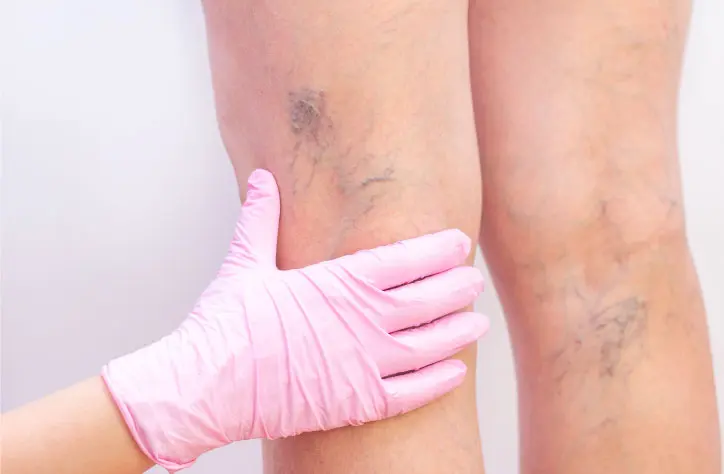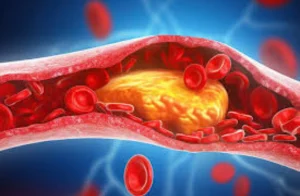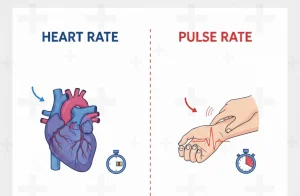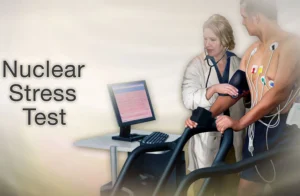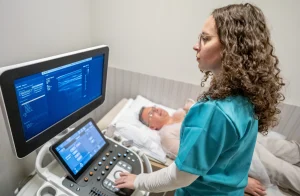Did you know that nearly 900,000 Americans are affected by deep vein thrombosis (DVT) each year? This serious condition can even be fatal if left untreated. On the other hand, those bulging, twisted veins that many people experience – varicose veins – affect roughly 23% of all adults. While not typically life-threatening, they can cause significant discomfort and impact quality of life.
It’s crucial to understand the key differences between these two conditions. This knowledge can help you to recognize the signs and symptoms and take swift action when necessary. Let’s start by examining the differences between these two conditions.
What is Deep Vein Thrombosis DVT?
Deep vein thrombosis, or DVT, is a serious condition where a blood clot forms in one of the deep veins, typically in the legs. These deep veins are responsible for carrying blood back to the heart. When a clot develops, it can partially or completely block the flow of blood, leading to a range of complications.
Causes of DVT
Several factors can increase your risk of developing DVT, including:
- Immobility: Prolonged periods of inactivity, such as during long flights or after surgery, can slow blood flow and increase the risk of clot formation.
- Injury or Surgery: Trauma to the veins or surgery can damage the blood vessels and trigger the clotting process.
- Certain Medical Conditions: Certain medical conditions, such as cancer, heart failure, and inflammatory bowel disease, can increase the likelihood of blood clots.
- Inherited Blood Clotting Disorders: Some individuals inherit genetic conditions that make their blood more prone to clotting.
- Other Risk Factors: Additional risk factors include pregnancy, obesity, smoking, hormone replacement therapy, and certain medications.
What are Varicose Veins?
Varicose veins are enlarged, twisted veins that often appear blue or dark purple, typically located just beneath the skin’s surface.
They are most commonly found in the legs but can also develop in other areas of the body.
Causes of Varicose Veins
Varicose veins occur when the tiny valves within the veins become weakened or damaged. These valves are responsible for ensuring blood flows in one direction, back towards the heart. When they malfunction, blood can pool in the veins, causing them to stretch and bulge.
Several factors can contribute to the development of varicose veins:

Weakened Valves: The primary cause is the weakening of the valves in the veins, which can be due to age, genetics, or other factors.
Age: The risk of developing varicose veins increases with age as the veins naturally lose elasticity and the valves become less efficient.
Family History: If you have a family history of varicose veins, you’re more likely to develop them yourself.
Pregnancy: The increased blood volume and hormonal changes during pregnancy can pressure the veins and contribute to varicose vein formation.
Obesity: Excess weight puts additional pressure on the veins, making them more susceptible to becoming varicose.
Prolonged Standing: Standing for extended periods can increase pressure in the leg veins, potentially weakening the valves.
Are Varicose Veins Early Signs of DVT?
Varicose veins are not typically considered early signs of DVT. These conditions affect different types of veins and have distinct causes and complications.
However, research suggests a potential link between the two conditions. Some studies indicate that having varicose veins might increase the risk of developing DVT, although more research is needed to understand this association fully. The connection may be due to shared risk factors or underlying mechanisms that affect both vein types.
Key Differences: Varicose Veins vs. Deep Vein Thrombosis
While varicose veins and DVT both affect the veins in your legs, they exhibit several fundamental differences that are crucial to recognize.
Location of Affected Veins
Varicose Veins: Primarily affect superficial veins located close to the skin’s surface.
DVT: Occurs in the deep veins situated within the muscles of the legs.
Severity and Urgency
Varicose Veins: Generally considered a cosmetic issue, although they can sometimes cause discomfort and lead to complications.
DVT: A potentially life-threatening medical emergency that requires immediate attention.
Symptoms
Varicose Veins: Visible, twisted, bulging veins beneath the skin; aching, heaviness, or fatigue in the legs; swelling in the ankles or feet; skin changes (dryness, itching, discoloration), Muscle cramps or restless legs
DVT:Pain or tenderness in the affected leg (often described as a cramp or charley horse); Swelling in the leg, ankle, or foot, usually on one side; Warmth over the affected vein; Redness or discoloration of the skin
Complications
Varicose Veins: Bleeding from the veins, Skin ulcers, Superficial thrombophlebitis (inflammation of a superficial vein due to a blood clot) – rare
DVT: Pulmonary embolism (PE), where the clot breaks off and travels to the lungs, blocking blood flow – this can be fatal; post-thrombotic syndrome (PTS), which causes long-term pain, swelling, and skin changes in the affected leg
Prevent heart problems before they start – Schedule a preventive checkup
Contact UsHow Does Treatment Differ for Both?
The treatment approaches for varicose veins and deep vein thrombosis (DVT) vary significantly, reflecting their distinct nature and potential complications. Let’s delve into the treatment options for each condition:
Treatment for Deep Vein Thrombosis (DVT)
The primary goals of DVT treatment are to:
- Prevent the clot from growing larger
- Prevent the clot from breaking off and traveling to the lungs (pulmonary embolism)
- Reduce the risk of developing another clot
Common treatment options for DVT include:
- Anticoagulants (Blood Thinners): These medications help prevent the clot from growing and reduce the risk of new clots forming. They are typically the first line of treatment for DVT.
- Thrombolytics (Clot Busters): In severe cases or when there’s a high risk of complications, thrombolytics may be used to dissolve the clot. These are powerful medications that are administered intravenously or directly into the clot.
- Inferior Vena Cava (IVC) Filter: If anticoagulants aren’t suitable or effective, an IVC filter may be inserted into the large vein in the abdomen to trap clots before they reach the lungs.
- Compression Stockings: These specialized stockings help improve blood flow in the legs and reduce swelling. They may be recommended after initial treatment to prevent post-thrombotic syndrome (PTS).
Treatment for Varicose Veins
Treatment for varicose veins focuses on:
- Relieving symptoms
- Improving cosmetic appearance
- Preventing complications
Several treatment options are available for varicose veins, depending on the severity and individual needs:
- Lifestyle Changes: Simple measures like weight loss, regular exercise, elevating the legs, and avoiding prolonged standing can help improve blood flow and reduce symptoms.
- Compression Stockings: These stockings provide graduated compression, helping to improve blood flow and reduce swelling in the legs.
- Sclerotherapy: A minimally invasive procedure where a solution is injected into the vein, causing it to collapse and fade away.
- Endovenous Ablation: Another minimally invasive procedure where heat or radiofrequency energy is used to close off the affected vein.
- Vein Stripping: A surgical procedure to remove the varicose vein. This is typically reserved for severe cases or when other treatments have failed.
If you have concerns about either condition, consult your doctor for personalized evaluation and treatment recommendations.
Words By Author
Understanding the distinction between deep vein thrombosis (DVT) and varicose veins is vital for recognizing potential risks and seeking timely medical care. DVT, a potentially life-threatening condition, necessitates immediate attention, while varicose veins, though less urgent, can still impact your quality of life. If you experience any symptoms of DVT, don’t hesitate to seek emergency medical help. For varicose veins, consult your doctor to discuss treatment options and improve your leg health.

